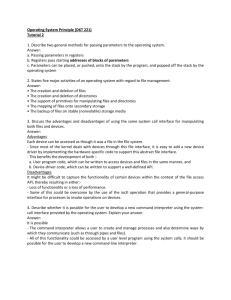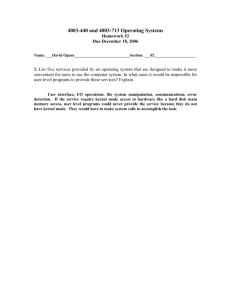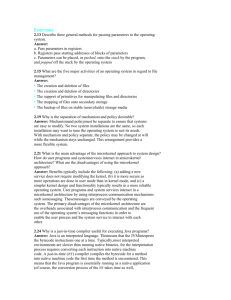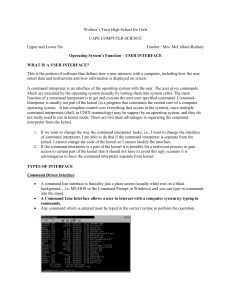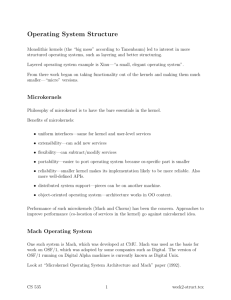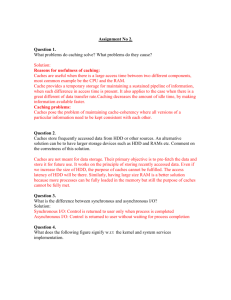CLASS EXERCISE 3 - Chu Hai College
advertisement
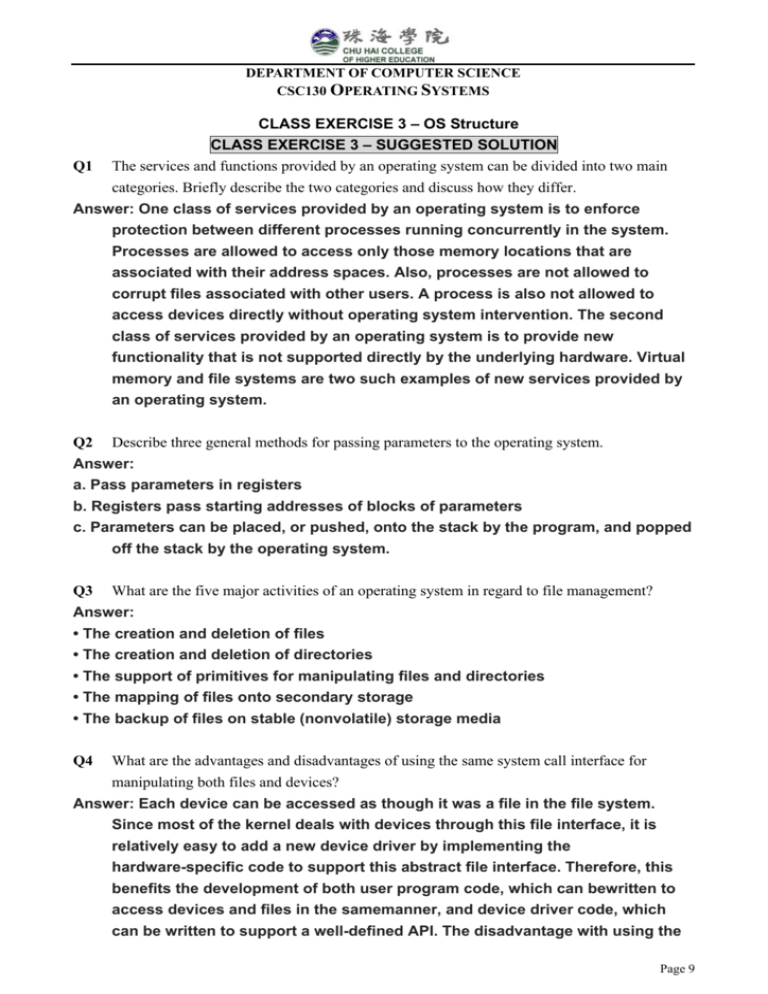
DEPARTMENT OF COMPUTER SCIENCE CSC130 OPERATING SYSTEMS Q1 CLASS EXERCISE 3 – OS Structure CLASS EXERCISE 3 – SUGGESTED SOLUTION The services and functions provided by an operating system can be divided into two main categories. Briefly describe the two categories and discuss how they differ. Answer: One class of services provided by an operating system is to enforce protection between different processes running concurrently in the system. Processes are allowed to access only those memory locations that are associated with their address spaces. Also, processes are not allowed to corrupt files associated with other users. A process is also not allowed to access devices directly without operating system intervention. The second class of services provided by an operating system is to provide new functionality that is not supported directly by the underlying hardware. Virtual memory and file systems are two such examples of new services provided by an operating system. Q2 Describe three general methods for passing parameters to the operating system. Answer: a. Pass parameters in registers b. Registers pass starting addresses of blocks of parameters c. Parameters can be placed, or pushed, onto the stack by the program, and popped off the stack by the operating system. Q3 What are the five major activities of an operating system in regard to file management? Answer: • The creation and deletion of files • The creation and deletion of directories • The support of primitives for manipulating files and directories • The mapping of files onto secondary storage • The backup of files on stable (nonvolatile) storage media Q4 What are the advantages and disadvantages of using the same system call interface for manipulating both files and devices? Answer: Each device can be accessed as though it was a file in the file system. Since most of the kernel deals with devices through this file interface, it is relatively easy to add a new device driver by implementing the hardware-specific code to support this abstract file interface. Therefore, this benefits the development of both user program code, which can bewritten to access devices and files in the samemanner, and device driver code, which can be written to support a well-defined API. The disadvantage with using the Page 9 DEPARTMENT OF COMPUTER SCIENCE CSC130 OPERATING SYSTEMS same interface is that it might be difficult to capture the functionality of certain devices within the context of the file access API, thereby either resulting in a loss of functionality or a loss of performance. Some of this could be overcome by the use of ioctl operation that provides a general purpose interface for processes to invoke operations on devices. Q5 What is the purpose of the command interpreter? Why is it usually separate from the kernel? Would it be possible for the user to develop a new command interpreter using the system-call interface provided by the operating system? Answer: It reads commands from the user or from a file of commands and executes them, usually by turning them into one or more system calls. It is usually not part of the kernel since the command interpreter is subject to changes. An user should be able to develop a new command interpreter using the system-call interface provided by the operating system. The command interpreter allows an user to create and manage processes and also determine ways by which they communicate (such as through pipes and files). As all of this functionality could be accessed by an user-level program using the system calls, it should be possible for the user to develop a new command-line interpreter. Q6 What are the two models of interprocess communication? Answer: The two models of interprocess communication are messagepassing model and the shared-memory model. Q7 What is the main advantage of the microkernel approach to system design? How do user programs and system services interact in amicrokernel architecture? What are the disadvantages of using the microkernel approach? Answer: Benefits typically include the following (a) adding a new service does not require modifying the kernel, (b) it is more secure as more operations are done in user mode than in kernel mode, and (c) a simpler kernel design and functionality typically results in a more reliable operating system. User programs and system services interact in a microkernel architecture by using interprocess communication mechanisms such asmessaging. These messages are conveyed by the operating system. The primary disadvantage of the microkernel architecture are the overheads associated with interprocess communication and the frequent use of the operating system’s messaging functions in order to enable the user process and the system service to interact with each other. Page 10 DEPARTMENT OF COMPUTER SCIENCE CSC130 OPERATING SYSTEMS Q8 In what ways is the modular kernel approach similar to the layered approach? In what ways does it differ from the layered approach? Answer: The modular kernel approach requires subsystems to interact with each other through carefully constructed interfaces that are typically narrow (in terms of the functionality that is exposed to external modules). The layered kernel approach is similar in that respect. However, the layered kernel imposes a strict ordering of subsystems such that subsystems at the lower layers are not allowed to invoke operations corresponding to the upper-layer subsystems. There are no such restrictions in the modular-kernel approach, wherein modules are free to invoke each other without any constraints. Q9 What is the main advantage for an operating-system designer of using a virtual-machine architecture? What is the main advantage for a user? Answer: The system is easy to debug, and security problems are easy to solve. Virtual machines also provide a good platform for operating system research sincemany different operating systemsmay run on one physical Page 11
